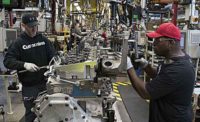When business conditions are slow, manufacturing engineers should take the opportunity to fine-tune their operations. Dave Gardner, president of Gardner & Associates Consulting (Reno, NV) offers these survival tips.
- Use downtime or slack time to focus on the improvement projects you didn’t have time to tackle during busier times.
- Sit down with your team members, either in groups or individually, and brainstorm ideas to increase productivity. Capture and prioritize the list in terms of impact. Put teams in place to work the high impact issues. Initiatives need a name and a date for reporting back.
- Engage in week-long lean, highly-targeted process improvement (Kaizen) projects. They should find solutions to key operational challenges and implement the ideas at the end of the process.
- Time-to-market is a function of having a design that can be manufactured in sufficient volumes to meet market demand. Tackle any supplier or supply chain issues. Ensure there is adequate sourcing of components. Ensure the continued financial viability of suppliers providing key components, particularly for any sole-sourced or single-sourced components. Work quality issues or manufacturability issues early and put plans in place to resolve them. Think about stumbling blocks encountered in prior projects and take action to void them again.
- Make sure your product development process identifies long-lead components early on you can order critical components to support prototype and pre-production builds. Understand the potential risk of any long-lead component’s likely suitability in the new design, and order parts or materials consistent with that risk.
- Product ideas don’t have to come from marketing. Brainstorm ideas about taking existing designs and making adjustments for different markets. Work those ideas with the executives in other areas. Leverage current designs and reduce your time to market.
